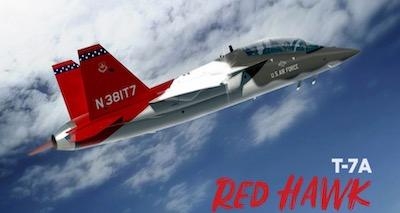Sun, May 07, 2023
Expected Release Date Slides by 3 Years After Continued Ejection Seat Problems
The T-7A Red Hawk jet trainer won't be expected to reach initial operational capability until spring of 2027 according to an Air Force release.

The aircraft was supposed to be the next-generation replacement for the long-in-the-tooth, but venerable, T-38 Talon. The T-X, as it was initially known, was hurriedly propositioned to replace the aged and increasingly weary Talons after more than 6 decades of service. When slated for adoption, the Air Force planned to have the Red Hawk in service in FY 2020. Budgets and politics got in the way, and its priority slid throughout the twenty-teens, culminating in the first production aircraft rolling off the line in late April of 2022.
No new aircraft is without its teething issues, and the T-7 appears to be no exception. Problems with the escape system and ejection process continued to grate against deadlines, with first deliveries from Boeing expected to take place sometime in December 2025. USAF acquisition chief Andrew Hunter told reporters that the T-7 isn't slated to hit IOC until 2027, with current ground evaluation focused on sled-testing before moving on to taxi tests. Despite watching what was once supposed to be a fairly high priority program for the Air Force - remember, airmen have died from fatigue failures in the T-38 Talon - the program continues to move at a meandering government pace. Perhaps most at fault is Boeing, however, working with Saab on their joint T-X program.
Currently, the bugbear of the T-7 lies in its problems with allowing a safe escape from an imperiled aircraft. While it was designed to accommodate a wider range of body types and pilot demographics, ejecting pilots risk high-speed concussions and a perilous amount of acceleration on ignition, all capped off by an equally dangerous deceleration when their parachute deploys. Once ready, the service expects to replace more than 500 of its T-38s with more than 350 T-7s - whenever it's ready, at least.
More News
From 2023 (YouTube Version): Legacy of a Titan Robert (Bob) Anderson Hoover was a fighter pilot, test pilot, flight instructor, and air show superstar. More so, Bob Hoover was an i>[...]
Get The Latest in Aviation News NOW on Instagram Are you on Instagram yet? It's been around for a few years, quietly picking up traction mostly thanks to everybody's new obsession >[...]
Aero Linx: B-52H Stratofortress The B-52H Stratofortress is a long-range, heavy bomber that can perform a variety of missions. The bomber is capable of flying at high subsonic spee>[...]
Altimeter Setting The barometric pressure reading used to adjust a pressure altimeter for variations in existing atmospheric pressure or to the standard altimeter setting (29.92).>[...]
"Knowing that we play an active part in bettering people's lives is extremely rewarding. My team and I are very thankful for the opportunity to be here and to help in any way we ca>[...]
 Classic Aero-TV: Remembering Bob Hoover
Classic Aero-TV: Remembering Bob Hoover ANN FAQ: Follow Us On Instagram!
ANN FAQ: Follow Us On Instagram! ANN's Daily Aero-Linx (05.15.24)
ANN's Daily Aero-Linx (05.15.24) ANN's Daily Aero-Term (05.15.24):Altimeter Setting
ANN's Daily Aero-Term (05.15.24):Altimeter Setting Aero-News: Quote of the Day (05.16.24)
Aero-News: Quote of the Day (05.16.24)



